Email Marketing for eCommerce Retention: 5 Messages to extend LTVs
What do you think of when you hear the infamous AOL voice going “You’ve Got Mail!”?
I’m instantly transported back to our family computer making horrible screeching dial-up noises in the corner of our living room. The first time I heard those words from Mr. AOL, it was a verification email saying my account, monkeyjr2003@aol.com, was active.
Man, what a thrill. I could talk to anyone!
Back then, getting a new email was like unexpectedly getting over 100 likes on a selfie. Or being retweeted by your favorite brand.
Before marketers ruined the trade, before obnoxious blasts and pushy sales flooded the channel, there was a time where customers were actually excited to get marketing emails.
Now, breaking through the noise of a customer’s inbox can feel nearly impossible for eCommerce brands. Despite this challenge, email is still the #1 channel for both acquisition AND retention.
Instead of looking at email marketing as a one-way sales channel, eCommerce subscriptions have to look at it as a layer of communication and engagement.
From your first point of contact to transactional emails and community-focused content, you have a chance to be unique in the inbox, stand out from the crowd, and deepen connections with your brand.
Email marketing is not dead. It’s your best chance to truly connect on a deeper level with your customers, provide a consistently exceptional experience, and create lasting, loyal fans.
So what retention emails should you actually be sending? And how are the best of the best winning with this channel?
Today, we’re breaking down 6 types of emails every subscription needs to be sending:
1. Welcome emails
For physical subscriptions, whether that be a curated box or a subscribe and save program, the first point of contact is a big one. Yes, they have given you their payment information and access into their lives, but that can all be changed in a moments notice.
Growing a subscription program isn’t just about making one sale. It’s a series of sales month after month (or quarter after quarter, depending on your cadenece).This first email gives your customer so much more than order details. It should give your customers a sense of what the subscription really means for them. How it works, where they go for help, what they can expect from your brand, and more.
The “more” is where you can really take advantage of this point of communication. Show your human side. Remind your customers of the deeper reasons they opted into your subscription, and be sure to start building that community right away.
Here’s a great example from Magic Spoon Cereal:

Things to note:
- The first line of this email is not only fun and inviting, but creates an immediate sense of being a part of something bigger.
- The imagery and design is exciting, eye-catching, and most importantly, very on-brand for Magic Spoon.
- Magic Spoon knows their ideal customer –someone who relates to the idea of being different, wacky, but wanting to connect with fellow “weirdos” (hello, it’s me!). They hit this nerve really well.
- Member perks are clearly laid out, driving home the idea that this subscription is so much more than cereal.
- Magic Spoon’s reference to learning the secret handshake may seem like a silly quip, but I actually think it’s a genius act of loyalty-building. There probably isn’t some secret handshake that every Magic Spoon customers knows but me, but it’s hinting that there’s a lot more to discover now that I’ve become a part of the family.
- It gets me extremely excited not just for the products I am about to receive, but for the experience I will get along with it.
This year, on a panel at ReCharge’s ChargeX Summit, Ryan Hogan, Founder and CEO of Hunt a Killer said, “From day 1 you should be building a community, focusing on things that are increasing LTV, and finding ways to get closer to your customer. Live and die by community first”
Your welcome email is day 1, don’t miss this opportunity.
2. Pre-shipment emails
Pre-shipment emails are a no-brainer retention booster because it’s your best chance to really get your customers excited about what’s coming to their doorstep.
Pre-shipment emails are often combined with welcome emails on the first order. Depending on the depth of your mission, this can work really well, or fall a bit short.
For example, this combo works really well for MeUndies. The brand comes across strong, every aspect of the membership is clearly outlined, and social proof is nicely placed near the end of the email:
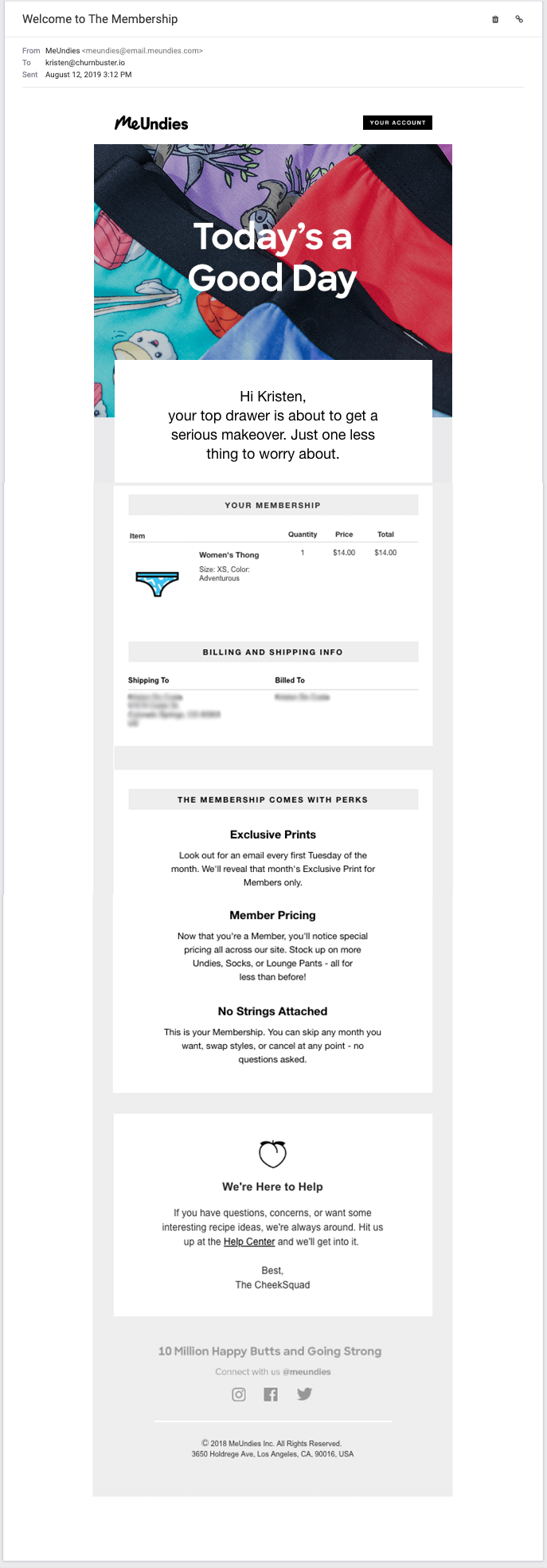
However, as we saw with Magic Spoon, these two aren’t always combined. And for many growing brands, separating these emails out can have a big impact on preventing early-stage customer churn.
Plus, only the first pre-shipment email has the luxury of potentially pairing with the welcome email, so you have to have a plan for the following shipments.
Yoga Club does a really good job enticing excitement in this pre-shipment email:

Things to note:
- Although I already know the pieces are picked for me every month, being reminded that a real human being is on the other side of the computer actually styling me is awesome. For a women-specific audience, this is huge. They’re building confidence before the pieces even get to their customers.
- Quick and clear tracking info– this is just something you should always have on your shipment emails.
- The bonus Lotus Bucks. Yoga Club makes a point to draw your eyes and attention to this section of the email. It’s showing that the subscription is, again, more than products in a box. You’re getting access to so much more because of your commitment as a subscription customer.
- A deeper mission is provided. Beneath the Lotus Bucks, you’ll see Yoga Club’s “One Box, One Class” mission. Again, remind customers what else they’ve invested in. This is connecting the brand back to humanity. It ties everything nicely together so the customer is actually excited about the delivery AND what that delivery means (on a larger scale).
Because pre-shipment emails can be done so many ways, let’s look at one more. This email from CauseBox is one of the best I’ve seen:

Things to note:
- Since CauseBox (like Yoga Club) is a curated box, they’re using this opportunity to drive home the feeling of Christmas. Everyone wants a sneak at their presents, and CauseBox gives it to their customers. A childhood dream come true for many of us. Not only does this get their customers excited about what’s coming, but it also allows them to start thinking about what they’re going to actually DO with those products. This is a great tactic for getting your customers in the right mindset.
- Each product sneak peak has a “learn more” link. CauseBox knows their customers and knows that the most connected ones are those who truly do care about the stories behind their products. That’s why people sign up (and stay) with CauseBox.
- Even further, the content on each product is so much more than a simple description. Customers get the full brand experience and access to the stories behind each product. CauseBox isn’t just delivering cool products from companies their customers believe in, they’re bringing culture, stories, inspiration, and love right into their customers’ inboxes. Pure gold.
- They mix up the content. The final piece of content on this email is actually a video with the artist who designed the fall CauseBox. There is so much depth to this email, I can only imagine how much engagement this emails got.
- They keep the excitement hanging. There’s more coming. By delivering such incredible content and connecting with their customers deepest motivations, CauseBox is subtly teaching their customers to trust, and subsequently open, their emails. This really sets CauseBox up for long-term success in regards to retention.
3. Upsell Emails
Let’s dig into a really important part of extending Customer LTVs… increasing the Average Order Values of your subscription customers.
And while this may seem easy on face value, it can be a lot trickier than meets the eye.
It’s easy to assume that since these customers are already on a subscription, they are so connected with your brand, opting in for new products is almost a no-brainer.
But that’s not always true. When someone is on subscription, it can be exceptionally difficult to get them to stray from the convenience aspect and get back onto your site to shop.
So, while new products and upsells are really exciting to your team, you have to approach this in a sincere, useful way to your customers.
The best upsell email I’ve ever seen comes from the branding legends over at BarkBox:

Things to note:
- BarkBox doesn’t just upsell their customers willy nilly. They strategically wait for an opportunity in their customers’ lives that could trigger this behavior. In this case, they chose the dog’s birthday. This really shows BarkBox’s dedication to actually understanding their customers. BarkBox customers likely care more about their pup’s birthday than their own. I mean… you’re buying monthly toys for your dog, not yourself. It’s not a crazy concept, BarkBox just leverages it really well.
- Again, they know their customers. It’s so obvious (and important) in this email, I have to point it out twice. They’re celebrating something very important to their customers, while adding in a nice little bonus for themselves (but really, I think the dogs win the most here).
- The action is simple. You click “add to my box” and boom, there it is. Done and done. If you’re going to upsell, do it at the right time, upsell the right product, and then make it exceptionally easy and delightful for the customer to actually do it.
- Barkbox addresses objections right up front. Before the customer even has time to worry that they’re being tricked into a subscription, BarkBox answers what we can only assume are the most common questions they receive from emails like this. Proactivity beats reactivity here.
4. Community-building emails
Like we talked about in the welcome email section, technically speaking, everything you do from checkout pages to email marketing should be trying to drive customers to that community.
But you should always look for ways to add a little fuel to the fire. Encourage your existing customers to connect on a deeper level. To open up to a community.
Also at ChargeX, Danny Taing, Founder and CEO of Bokksu said, “It’s about the passion, people have a passion for WHY they’re signing up, right there they want to feel a part of it.”
In these community-building emails, you want to focus on the passion, the mission, and the connections behind your brand. And if you’re not sure what that really is, you better get to talking to your customers and figure it out.
Let’s look at some examples. First up, check out this social-community building email from Bite Toothpaste:
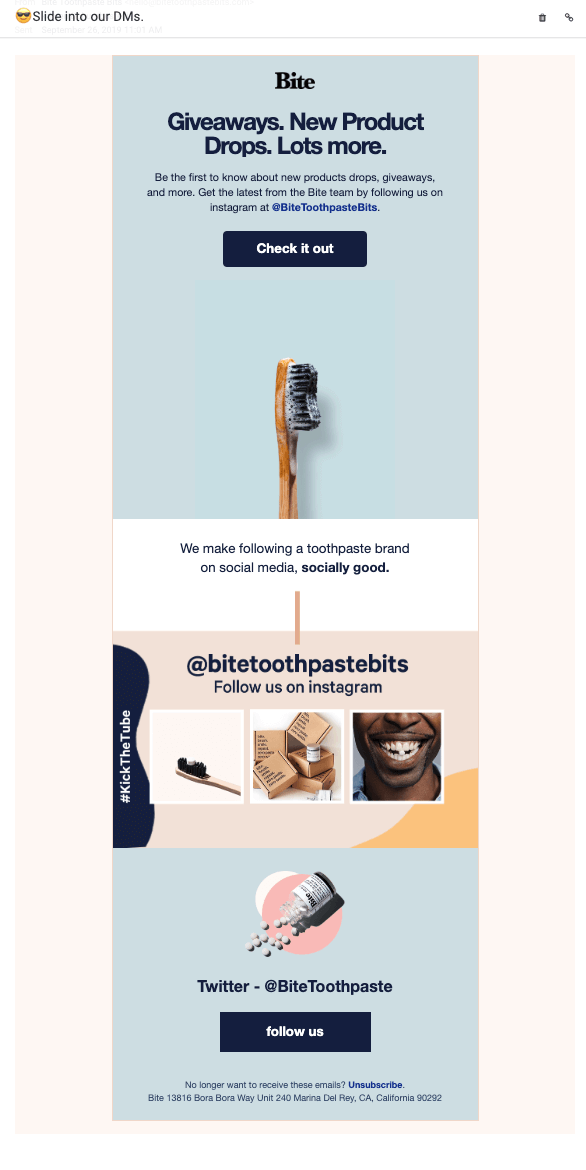
Things to note:
- This email is not entirely focused on the product, but the community behind the product.
- Bite committed and entire customer touchpoint to growing their Instagram. AKA, growing the digital community. The more their customers engage with the brand on multiple platforms, the deeper the relationship becomes. Bite clearly knows this and drives customers to do exactly that.
- Bite (and you might be getting tired of me saying this) knows their customers. They understand that there is a deep connection to the idea of sustainability and ethically focused brands. They ride this message all the way through their Instagram. “We make following a toothpaste brand on social media, socially good.”
Here’s another incredible example from BeardBrand:
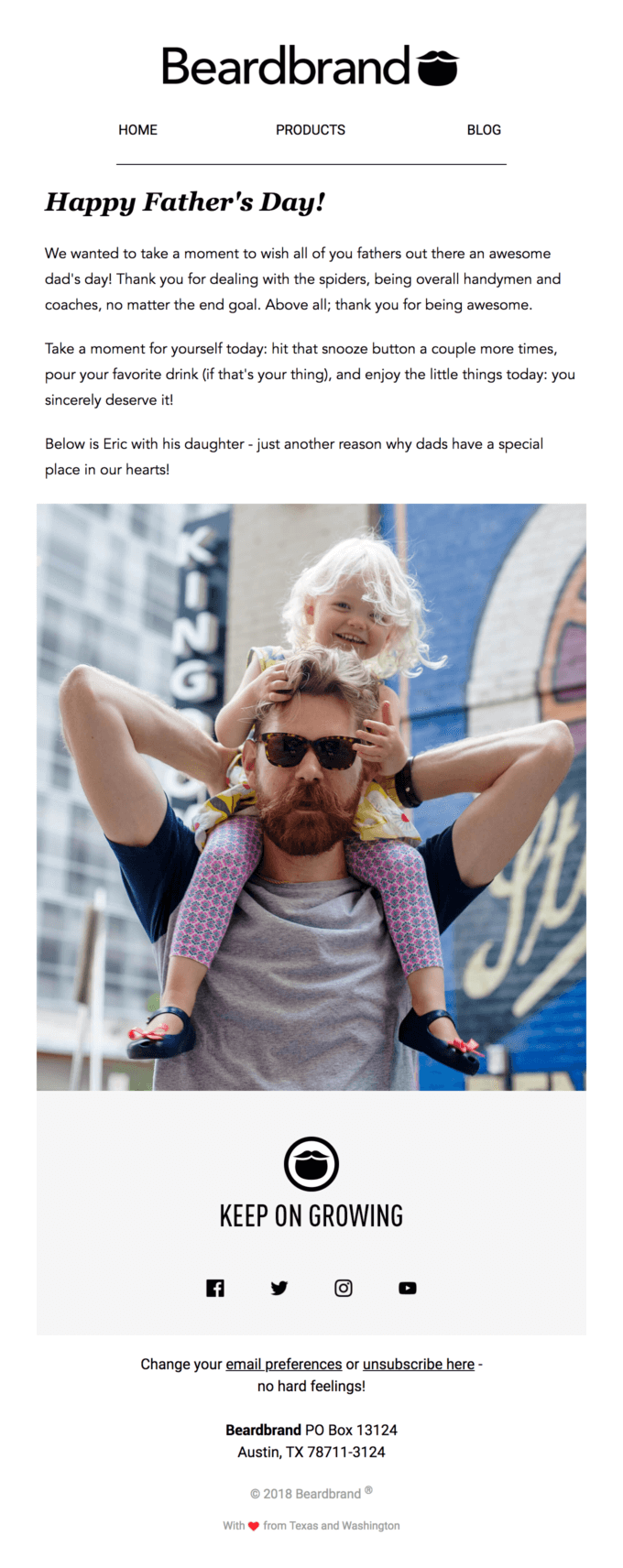
Things to note:
- There are so many layers of impressive here. First of all, do you see a single sales CTA in this entire email? No? They’re not selling, they’re connecting. Bravo, BeardBrand.
- BeardBrand is celebrating a main cohort of their customers. So much of community building is about actually helping and supporting your customers, in all aspects of their lives (not just the parts that directly interact with your products). BeardBrand… wait for it… knows their customers. They’re hitting on messages that, for lack of a better phrase, hit the customers right in the feels. And it works.
- It allows the customers to relate to the brand on a human level. Not only is BeardBrand saying “Hey we see you out there, dads, you’re amazing,” they’re also saying, “Look! We’re run by a family-loving father, too.” They’re not just talking the talk, but they’re walking the walk. And putting a true, genuine face to the business. I’m not a father and even I feel a connection to Eric in this moment. That’s really powerful.
5. Brand-building emails
This is another one of those “every email should be this” cases. Just like your community building efforts, honing in on your brand values and mission should be happening, whether expressly or subtly, in every single point of contact your customer has with your company.
Like community-building, this is weaved throughout all of your emails, but is worthy of separating out into their own communications as well.
As you’re building a rapport with your customer and extending those relationships for LTV purposes, it’s really powerful to clearly and obviously bring attention to what you represent as a brand.
This email from Blume is simply amazing:

Things to note:
- Blume is addressing a larger, societal problem that they know their customers care about.
- They’re building a brand stance on a very powerful movement, in turn, creating their own movement. This can attract high brand-affinity for customers looking for a deeper connection (aka, the easiest ones to retain).
- They created their own entire piece of content for this important mission. They’re not just saying they want to contribute to this mission, they’re really doing it. The customers are going to take notice of that commitment.
- Blume gives their customers clear and actionable next steps for becoming a part of the mission. They even go so far as to provide social copy AND graphics (that are conveniently branded by Blume to spread the brand name).
- The founder and CEO of Blume actually wrote a Medium post on their stance. They’re removing the curtain between business and consumer. Bringing a face to the business and to their deeper mission. Just like BearBrand did in their community-building email, this is really well executed.
6. Dunning Emails
In eCommerce, there’s not a lot of blanket statements that ring true. Almost every piece of advice comes with a bit of “it depends” tied to it. But here’s one thing I can confidently say: No matter what you’re selling, every eCommerce subscription is facing the issue of passive churn.
On average, up to one fifth of recurring credit card payments can fail per month.
Let that sink in. That’s up to 20% of your monthly revenue at-risk every single month.
When you need to email your customers about this issue, it can either be a pleasant and seamless experience, or an invasive and spammy one.
How you approach this issue can leave your business bleeding revenue in a black box of uncertainty, or recovering 60% those payments and keeping subscriptions alive.
From a high-level, there are a few things you should be focusing on in dunning emails:
- Don’t email unless you have to….
Woah, woah, we’re talking about dunning EMAILS right? Right. But, for monthly subscriptions, fewer than 40% of payment failures actually require a new card on file, and over 50% of failures can be fixed without needing updated information from your customer. Decouple retries from your emails and give it 2-3 days after a failure before ever reaching out to your customer. Companies working with Churn Buster with this approach are recovering 63% of failures without ever getting a new card on file (average). - When you do email, make the emails trustworthy. Sender information should be clear and white-labeled and your email content should be simple and straight to the point.
- Keep your branding front and center. Like I’ve said, every touchpoint needs to be a great experience that reinforces the deeper values you provide. In these emails, highlight what your customers are going to miss by not acting.
The best recovery campaigns are highly optimized to recover revenue while protecting the customer experience. This can be really tricky to master on your own, so here are some dunning best practices to get you started.
Check out this example from Four Sigmatic (it’s amazing):
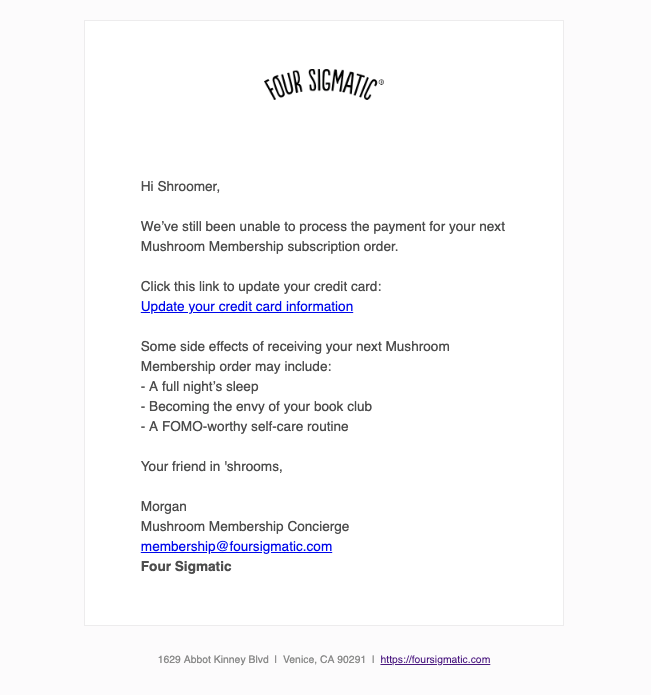
Things to note:
- The email is branded, but not overbearingly so. Simple logo and design build trust but not distract.
- The messaging in this email is wonderful. It clearly states the issue, provides the solution, and even goes as far as to point out the benefits their customer is missing out on by missing a shipment. It’s reminding customers of their why.
- The email is sent from a recognizable person in the organization (Morgan, Member Concierge) who members are used to communicating with. This makes the email extremely trustworthy.
After a failed payment, it’s frighteningly simple for a customer to simply slip away. This isn’t an email to take lightly. There’s real money on the table, make sure you’re applying the same level of commitment to this area as you are the more “fun” communications.
7. Educating on the How
No matter what your selling, you need customers to not only engage with your brand, but also the products themselves. This may seem like another no-brainer, but these Educating on the How emails are often overlooked.
For replenishment subscriptions or subscribe and save programs in particular, teaching your customers how to get the most value from the products is key to retention. Building customer habits is important to retaining customers and preventing the “too much volume” churn.
From personalization to app development, large companies like Ritual are focusing hard on this particular area for good reason.
Getting a customer on your subscription is one thing. Connecting with them as human is another.
But getting your customer to actually FEEL the benefit of your products is the real ticker here. What good is a subscription if your customers aren’t actively using the products your sending?
Let’s see how Harry’s does this:
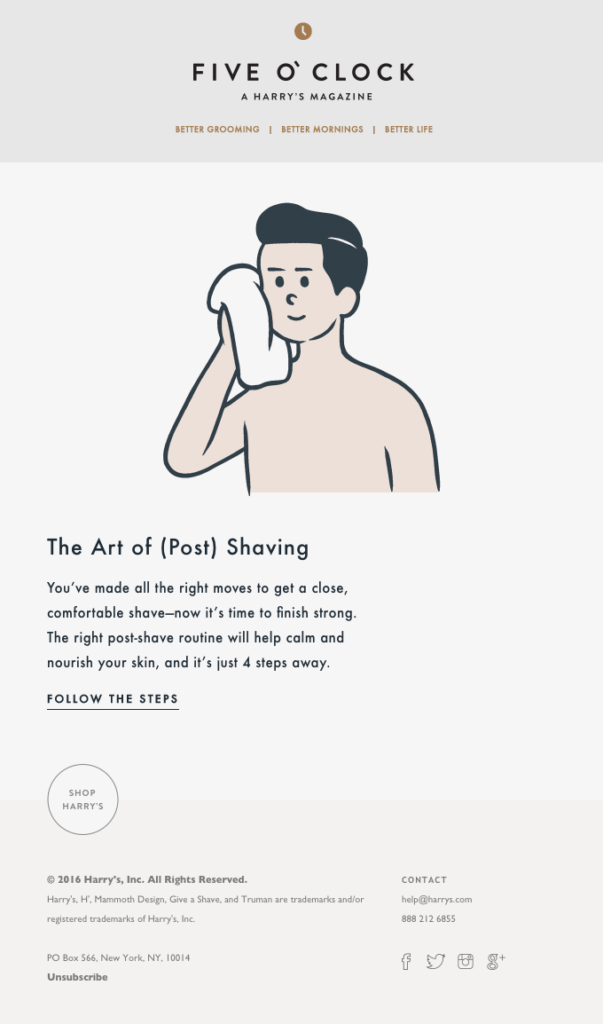
Things to note:
- Harry’s isn’t just supplying the best products in hair removal, they’re also teaching their customers how to actually get the most out of them.
- This email leads nicely into upsells into other products for Harry’s. But first and foremost, it’s about helping their customers find true success (a great shave experience).
- The email links to easily digestible (4-steps) content that is encouraging Harry’s users to not only use their products, but use them well. And ultimately… begin to bring more of their bathroom experience to Harry’s. Win-win.
Wrapping up:
Email marketing gets a bad rap in the acquisition game. But it’s still the most effective channel for promoting deeper customer relationships and in turn, increasing LTVs and reducing churn.
And one of the best parts about email is the constant feedback loop with your customers- after all, between open rates, clicks, and direct responses, you can consistently learn more about what works and what doesn’t.
So for all of these pieces, we highly recommend setting up automation and segmentation based on engagement.
The more a customer is engaging with your emails, the more you can interact with them and build it deeper. However, if a customer isn’t engaging with any of your emails (no matter how wonderful they are), make sure your system is set up to take a step back and give them some breathing room.
Remember: You want every interaction with your brand to be wonderful. And you are not the judge of that, your customer is.
Make sure you are paying attention to the behavior of your customers, it will allow you to create personalized funnels that will continually retain your base.
About the writer:
Kristen DeCosta. Kristen is the lead on all things education, retention, and growth-related at Churn Buster. She’s obsessed with creating meaningful customer relationships and showcasing the human side of subscription businesses.
Kristen has worked with hundreds of top companies (including ButcherBox and LOLA) to improve MRR and build deeper connections with their customers.






